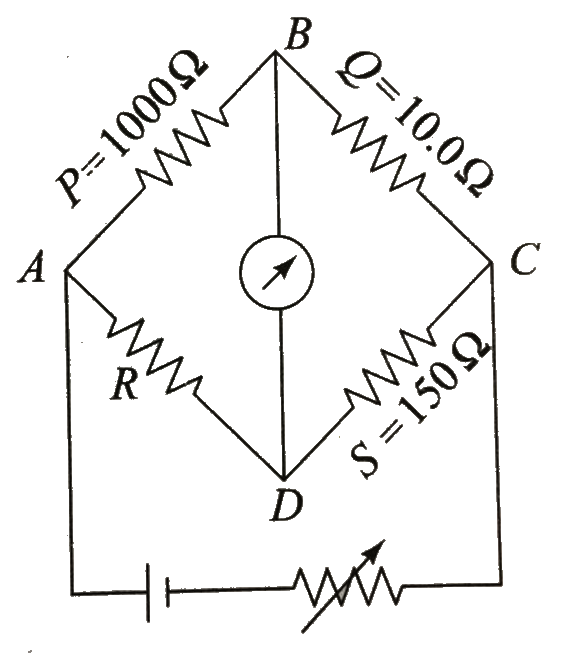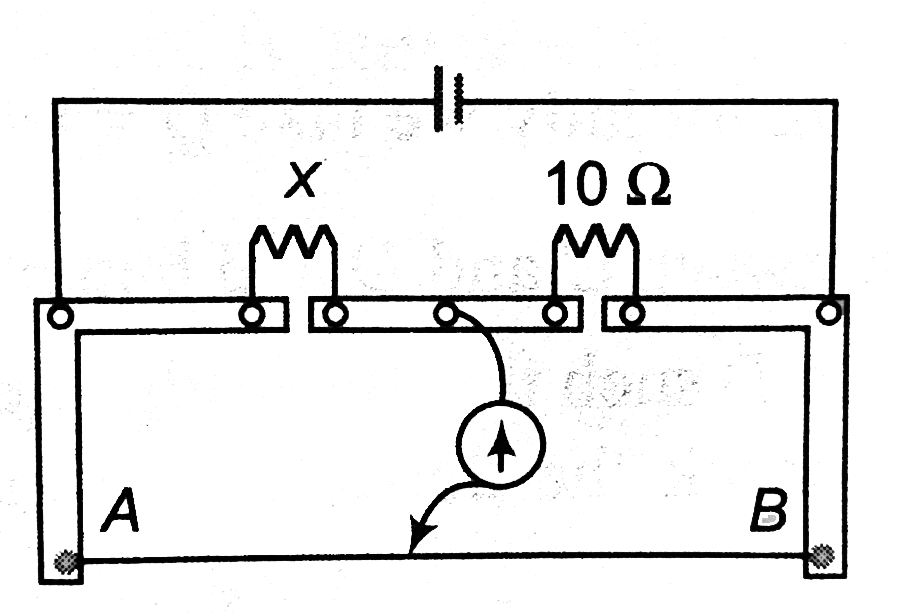Figure , shows a wheatstone net, with ,,(unknows), variable and near for balance. If the connections across and are interchanged, the error range in R determination would

remain unaffected
increase substantially
increase marginally
decrease substantially
The correct Answer is:D
is the order of The junctions of the heighest two an dthe lowest two resistances are and , and for better sensitivity, the galvanometer will be between these. So, error will decrease with the suggested interchange.
Alternatively : Let be not exactly . Then some potential difference will be creates between points and . Let it be . Now suppose the connections are interchanged, then the same type of potential difference will be created between points and . Let it be . So larger current will flow through galvanometer in the second case telling us that value of needs to be changed. And we will try to put more accurate value of . In this way, error will decrease.
Topper's Solved these Questions
- ELECTRICAL MEASURING INSTRUMENTSBook:CENGAGE PHYSICS ENGLISHChapter:ELECTRICAL MEASURING INSTRUMENTSExercise:Multiple Correct
Explore 7 Videos
- ELECTRICAL MEASURING INSTRUMENTSBook:CENGAGE PHYSICS ENGLISHChapter:ELECTRICAL MEASURING INSTRUMENTSExercise:Assertion-Reasoning
Explore 7 Videos
- ELECTRICAL MEASURING INSTRUMENTSBook:CENGAGE PHYSICS ENGLISHChapter:ELECTRICAL MEASURING INSTRUMENTSExercise:Subjective
Explore 18 Videos
- ELECTRIC POTENTIALBook:CENGAGE PHYSICS ENGLISHChapter:ELECTRIC POTENTIALExercise:DPP 3.5
Explore 15 Videos
- ELECTROMAGNETIC INDUCTIONBook:CENGAGE PHYSICS ENGLISHChapter:ELECTROMAGNETIC INDUCTIONExercise:compression type
Explore 7 Videos
Similar Questions
The figure below shows a wheatstone bridge with resistors P and Q having almost equal resistance. When R = 400Ω , the bridge is in balanced condition. If on interchanging P and Q, the bridge is again balanced for R=405Ω, then the value of X is

View SolutionFigure6.52 shows a balanced wheatstone net. Now, it is disturbed by changing P to 11Ω. Which of the following steps will not bring the bridge to balance again?

View Solution
Knowledge Check
In a Wheatstone's network, P=2Ω,Q=2Ω,R=2ΩandS=3Ω. The resistance with which S is to be shunted in order that the bridge may be balanced is
 A1ΩB2ΩC4ΩD6Ω
A1ΩB2ΩC4ΩD6Ω
A resistance of 2Ω is connected across one gap of a meter bridge (the length of the wire is 100cm and an unknown resistance, greater than 2Ω, is connected across the other gap. When these resistance are interchanged, the balance point shifts by 20cm. Neglecting any corrections, the unknown resistance is.
(a)3Ω
(b) 4Ω
( c) 5Ω
(d) 6Ω.
View SolutionThe resistance of the four arms A, B, C and D of a wheatstone bridge as shown in the figure are 10Ω, 20Ω ,30Ω and 60Ω respectively . The emf and internal resistance of the cell are 15V and 2.5Ω respectively . If the galvanometer resistance is 80Ω then the net current drawn from the cell will be
_PHY_E05_111_Q01.png)
View SolutionFigure shows a battery with emf 15 V in a circuit with R1=30Ω,R2=10Ω,R3=20Ω and capacitance C=10μF. The switch S is initially in the open position and is then closed at time t= 0. What will be the fimal steady - state charge on capacitor?

View SolutionFour resistors A, and D form a Wheatstone bridge.
The bridge is balanced , when C = 100Ω If A and B are interchanged the bridge balances for C=121Ω. The value of D is
View SolutionIn the Wheatstone network given, P=10Ω,Q=20Ω,R=15Ω,S=30Ω, the current passing through the battery (of negligible internal resistance)

View SolutionA meter bridge is set- up as shown in figure, to determine an unknown resistance X using a standard 10Ω resistor. The galvanometer shows null point when tapping - key is at 52cm mark. The end -corrections are 1m and 2cm respectively for the ends A and B. The determined values of X is .

(a) 10.2Omeaga
(b) 10.6Ω
(c) 10.8Ω
(d) 11.1Ω.
View SolutionFigure shows a potentiometer arrangemeter with RAB=10Ω and rheostat of variable resistance d. For x=0 null deflection point is found at 20cm from A. For unknown value of x null deflection point was at 30cm from A, then the value of x is

View Solution